
|
|
From the Editor - January 2023
This is the ninth time that I’ve been able to express New Year’s greetings through this website. Yes, I’ll soon be commencing my tenth year of sharing these articles with you on my own site! When I started out way back in April Here in British Columbia on Canada’s traditionally Wet Coast, winter has finally arrived - sort of! Much of December 2022 remained far dryer than usual, leaving us almost unbelievably still in a Level 5 drought situation as Christmas drew near despite the odd day during which we had some light rain and snow. Our wildfire season lasted into November this past year - almost unheard of! It wasn't until shortly before Christmas that we had our first serious dump of snow. However, this didn't by any means get us out of the woods - the temperatures have since climbed back up to unseasonably high levels, at least in my coastal area, causing most of the snow to melt already. We have still yet to begin accumulating the heavy mountain snowpack which will be required to see us through next summer. I fear for our water supply in 2023 given our dependence on snowmelt to see us through.……. Looking further afield as we head into 2023, the global situation has not improved - we find ourselves still facing many of the same challenges that we had to confront during 2022. The festering Ukraine situation; North Korea’s posturing; the inexplicably rising political influence of the far-right conspiracy theorists whose efforts have done so much to compromise the futures of both their supporters and the rest of us; the seemingly uncheckable spread and blind embracing of misinformation on so many important topics such as the evolving climate emergency to which there’s an ongoing global failure to respond - all of these factors contribute to the ongoing global instability. As if this wasn’t enough, we continue to face the triple threat from the still-circulating Covid virus, the virulent strains of influenza now going the rounds and Respiratory Syncytial Virus (RSV). Looking at the situation realistically, I suppose that all we lesser mortals can do is carry on as best we’re able while exercising due caution, which is what I’m doing. It really does help to know that there’s still an ongoing interest in model engines among my valued readers - that’s what keeps me going! My statistics reporting system has continued to report very encouraging visitation figures.
In last month’s issue, I reported that my long-standing friend and colleague Tim Dannels has finally decided to hang it up and cease publication of his invaluable “Engine Collector’s Journal” (ECJ) after almost 60 years. I received issue 270, Volume 46, no. 6 in the mail during December, and that issue will be the last. At age 87, I reckon that Tim has paid his dues - he richly deserves a break from the effort of putting out his regular issues. It had to happen sometime, but no longer receiving those issues in my mailbox will represent a real loss - I’ll miss them! Our shared debt to Tim for his efforts over the years can never be adequately repaid. It was an honour for me to have an article of mine selected by Tim to form part of the final issue. This is my evaluation of the very rare Premier Lionheart “faux twin”, which was also picked as the cover illustration. In addition, there’s a review by Maris Dislers of the very rare Cométe Junior 5A diesel. If you haven’t been an ECJ subscriber over the years, you’ve really been missing out! Thankfully, back issues will continue to be available, at least for a while. At least Tim is still with us, telling me that he intends to retain an active interest in the hobby to which he has given so much. Sadly, the same cannot be said for another true giant of the model engine world - Clarence Lee. Tim has passed along the news that Clarence passed away on December 28th, 2022 at age 99, having been pre-deceased on December 21st by his 96 year old wife of 76 years, Peggy. Tragically, both of them died as a result of an accident at their home, where they were still living independently despite their advanced ages.
On a far happier note, a very welcome contact came from Ingemar Larsson of Sweden, who sent me another of his own customized modelling-oriented Christmas/New Year’s cards. I enjoyed this so much that I thought it to be worth sharing with my readers! Thanks, Ingemar!
Speaking of magazines, the arrival of “AeroModeller” magazine in my mailbox is always a welcome event! Issue no. 1028 for January Speaking of publications, I've recently become aware of yet another outstanding periodical which focuses on "classic" aeromodelling. This is the Spanish-language on-line bulletin entited "Boletin Aeromodelismo Toledo" (BAT), which is produced by the great enthusiast Fernando González. It's chock full of interesting and authoritative articles on past and present classic aeromodelling of all genres, also including a good deal of information on engines of the classic era. The fact that it's in Spanish is no impediment - it's easily rendered into any language that you choose using readily-accessible translation software. Issue no. 21 has just appeared. In addition to many very informative articles of a wide range of topics, it includes an article by Yours Truly on the Byra engines from Barcelona. I'm honoured to have been able to contribute to this fine effort by a true enthusiast! If you're interested, contact Fernando at boletinaeromodelismotoledo@gmail.com to request access. An unexpected but very welcome contact came out of the blue from my long-time friend and colleague Don Sohn of Oshkosh, Wisconsin, USA. Don is one of America’s most respected engine builders. A number of his fine engines have appeared in various articles on this website. I've summarized his impressive list of accomplishments at the end of my article on the engines of Ira Hassad.
In 2022 as he turned 88 years old, Don was understandably becoming concerned regarding the need to ensure that the history of the Yellow Jacket project was not allowed to die with him. With the able assistance of Tim Dannels, the available material was organized into a 36 page booklet format. Don subsequently made arrangements with me to have this material appear on my website. As a result, the Yellow Jacket story may now be found on this site. Consider it a bonus read for the New Year! One of the great advantages of publishing articles such as mine on a website as opposed to in hard-copy book form is that updates and amendments to the material are readily incorporated as and when they become available. Consequently, I always view the articles on this website as works in progress, remaining ready at all times to make changes as additional information becomes available.
One of those sources was a 1995 article by Wes Pettinger of Texas which was published that year in the MECA Bulletin. With the much-appreciated help of current MECA President Dave Zwolak, I was able to establish contact with Wes, who is still active 27 years later and was only too pleased to assist by providing additional images and comments. As a result, the Mite .099 article on this website has now been comprehensively updated. I’m sure that anyone interested in the Mite diesel will find the revised article to be far more informative than its predecessor. Thanks, guys!!
Lyndon also provided images of ETA 29 Mk. I no. 3105, which is the lowest serial number for that model yet encountered. As if this wasn’t enough, he also set me straight on a number of important details which I had got wrong in the “Background” It was really great to hear once again from Steve Todd of Australia, whom we last met in connection with the article about the Elfin 149 replicas. Steve read my comments in last month’s Editorial relating to the Zeus CX-2.5D, in which I mentioned a plan by Ivor F to build a 5-cylinder radial powerplant based upon Cox components, of which Ivor had somehow acquired an impressive stock. Steve advised that Ivor gave him a heap of Cox stuff many years ago, also mentioning his ideas about building a radial engine using such components. Steve told Ivor that he would have a go at building a three-cylinder version. He made a good start on this project, as seen in his I’ve been fortunate enough to acquire several more rare and distinctive engines for evaluation Turning now to this month’s lead articles, we make a return visit to America to take a close-up look at what many readers may see as one of the more mundane and hence inconsequential products of the US model engine manufacturing industry - the humble little McCoy “9” glow-plug model of 1949 - 1956. This unpretentious little .098 cuin. unit may appear to be unworthy of my attentions, but in fact it’s a far more significant motor than most people realize. The fact that both Tim Dannels and Wes Pettinger have independently cited it as one of their all-time favourite engines should tell you something …………..
Since this is the New Year edition, I though that it wouldn’t be out of place to bring in the New Year with a second all-new lead article this month. A number of my valued friends and colleagues have heard about my recent The 3.5 cc Weston “Stunt Special” was the final engine produced by (or more probably for) Weston Model Aero Supplies of 1 Oxford Street in Weston-super-Mare, Somerset, England. The engine appeared in early 1949, replacing an earlier side-port Weston "B" model. It was a lightweight crankshaft front rotary valve (FRV) diesel of reasonably up-to-date design. A test by Lawrence Sparey appeared in the June 1949 issue of "Aeromodeller", but this undoubtedly did far more harm than The MEN transfer article for the month is a re-mounting of my original article on the M.E.C. 1.2 cc diesel from North London, England which originally appeared on MEN in August 2010. I’ve been able to add a little extra information to this article, besides which it needs to be protected against potential loss as the frozen MEN website slowly deteriorates due to the lack of any opportunity to carry out maintenance activities. I think that it’s a story which is well worth preserving - hope you agree!
I think that about does it for this edition. All being well, I'll be back to you with another edition on or about February 1st, 2023. Meanwhile, please accept my best wishes for continuing the process of learning to live with the various challenges which now beset us so as to get the best of what life still has to offer under present circumstances. Take care and stay well - keep yourself informed from credible unbiased sources and trust your own informed opinions rather than the fantasies of others whose focus is entirely on themselves, not on you. Ignore them and the misinformation that they spread, make up your own mind based on authoritative current information and act accordingly! It’s your future and that of your kids and grandkids .……….don’t let others having conflicting self-centred agendas decide it for you and for them! Cheers, Adrian Duncan British Columbia, Canada ___________________________________ Note regarding material to be found on this site - unless specifically otherwise noted, all images and text which appear on this site are my own work, and I hereby assert my right to be recognized as the originator of this material. For the record, this material is made freely available to all upon two firm conditions:
Adrian C. Duncan British Columbia, Canada |
| |
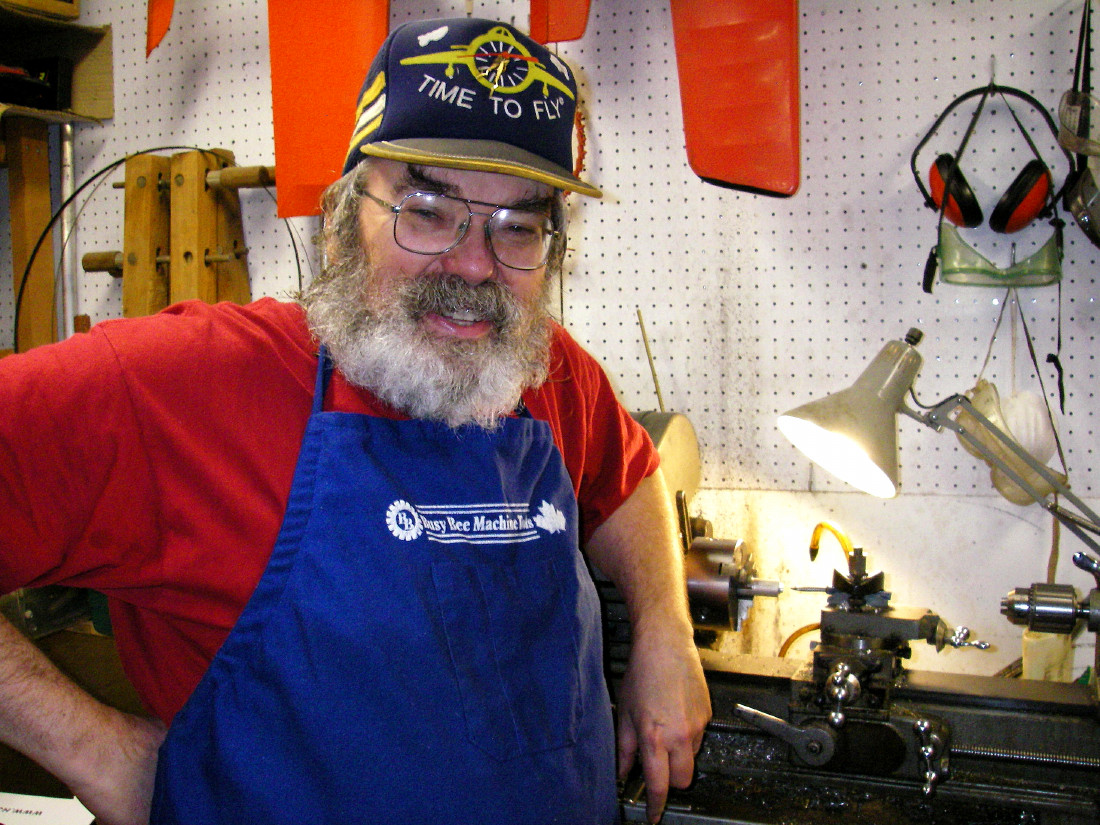 Happy New Year from Canada once again! I hope that you managed to get your share of holiday cheer with friends and family over the festive season and that you’ve successfully weathered the storm resulting from the consequent assaults upon your digestive system! For my part, I seem to have survived the annual celebratory binge reasonably intact, living to fight another day! I hope very sincerely that the recent festive interlude has provided you all with an opportunity to unwind a little and brace yourselves for the upcoming round in 2023!
Happy New Year from Canada once again! I hope that you managed to get your share of holiday cheer with friends and family over the festive season and that you’ve successfully weathered the storm resulting from the consequent assaults upon your digestive system! For my part, I seem to have survived the annual celebratory binge reasonably intact, living to fight another day! I hope very sincerely that the recent festive interlude has provided you all with an opportunity to unwind a little and brace yourselves for the upcoming round in 2023!  2014 following 6 years as a regular contributor to the late Ron Chernich’s “
2014 following 6 years as a regular contributor to the late Ron Chernich’s “ Confirmation that a significant number of folks are seeking an escape from all that ails us by remaining very much engaged with our hobby comes from the fact that the mail box has remained quite active. Despite the many distractions now preying upon us, I still heard from quite a few of you during December, including (in no particular order) Peter Valicek, Gordon Beeby, Derek Butler, Luis Petersen, Maris Dislers, Wes Pettinger, Dean Clarke, Tim Dannels, Don Sohn, Tom Coletta, Alistair Bostrom, Dave Zwolak, Ilya Leydman, Otto Mederle, Lyndon Bedford, Peter Scott, Tahn Stowe, Mike Noakes, Ken Croft, Larry Davidson, Pat Hardy, Stuart Holder, Sheldon Jones, Ron Hiltz, Laurence Cooper, Mark Boesen, Hugh Blowers, Roger LaPrelle, Steve Todd, Ingemar Larsson, Chris Coote, Miles Patience, Peter Rathke, Michael Isermann, Tab Hornburg, Fernando González and Neill McRae. Apologies to anyone whom I may have inadvertently missed in the crowd, and apologies also to anyone whose message(s) went unanswered - things do slip through the cracks, especially when I’m
Confirmation that a significant number of folks are seeking an escape from all that ails us by remaining very much engaged with our hobby comes from the fact that the mail box has remained quite active. Despite the many distractions now preying upon us, I still heard from quite a few of you during December, including (in no particular order) Peter Valicek, Gordon Beeby, Derek Butler, Luis Petersen, Maris Dislers, Wes Pettinger, Dean Clarke, Tim Dannels, Don Sohn, Tom Coletta, Alistair Bostrom, Dave Zwolak, Ilya Leydman, Otto Mederle, Lyndon Bedford, Peter Scott, Tahn Stowe, Mike Noakes, Ken Croft, Larry Davidson, Pat Hardy, Stuart Holder, Sheldon Jones, Ron Hiltz, Laurence Cooper, Mark Boesen, Hugh Blowers, Roger LaPrelle, Steve Todd, Ingemar Larsson, Chris Coote, Miles Patience, Peter Rathke, Michael Isermann, Tab Hornburg, Fernando González and Neill McRae. Apologies to anyone whom I may have inadvertently missed in the crowd, and apologies also to anyone whose message(s) went unanswered - things do slip through the cracks, especially when I’m 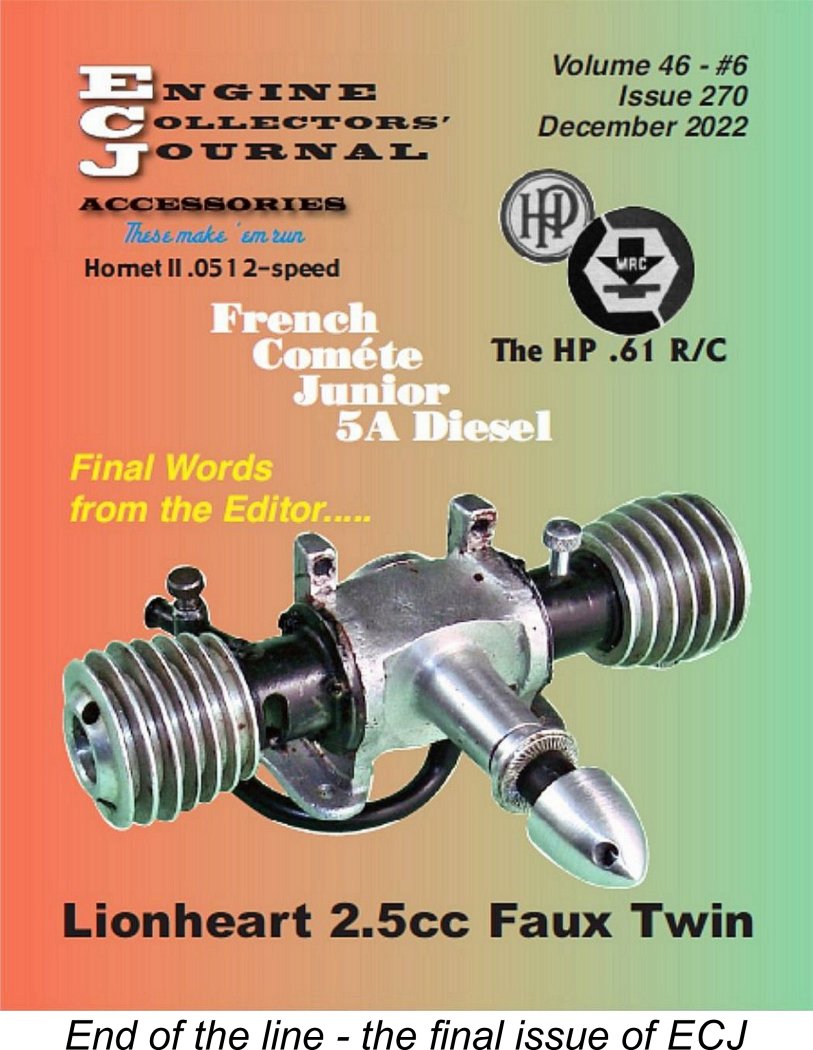
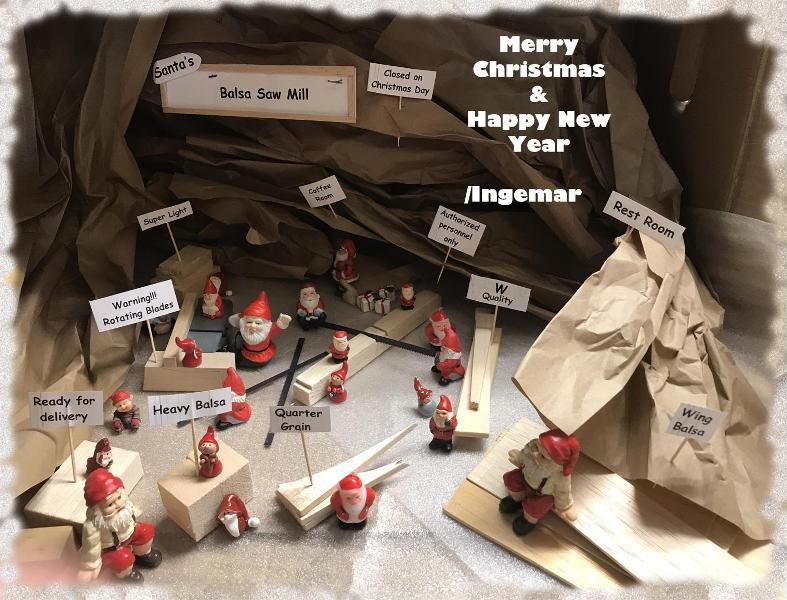
 Ingemar also advises that he has now completed issue no. 2-22 of the outstanding magazine “
Ingemar also advises that he has now completed issue no. 2-22 of the outstanding magazine “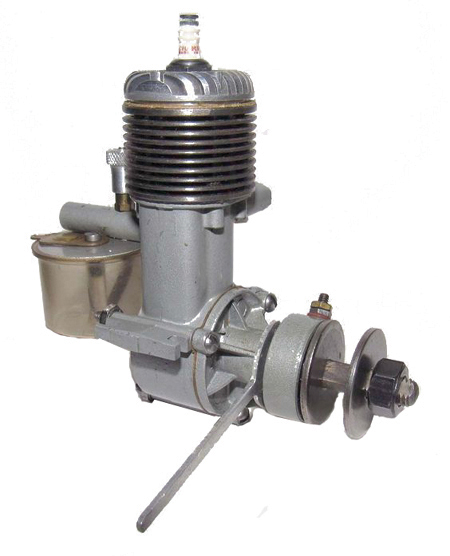

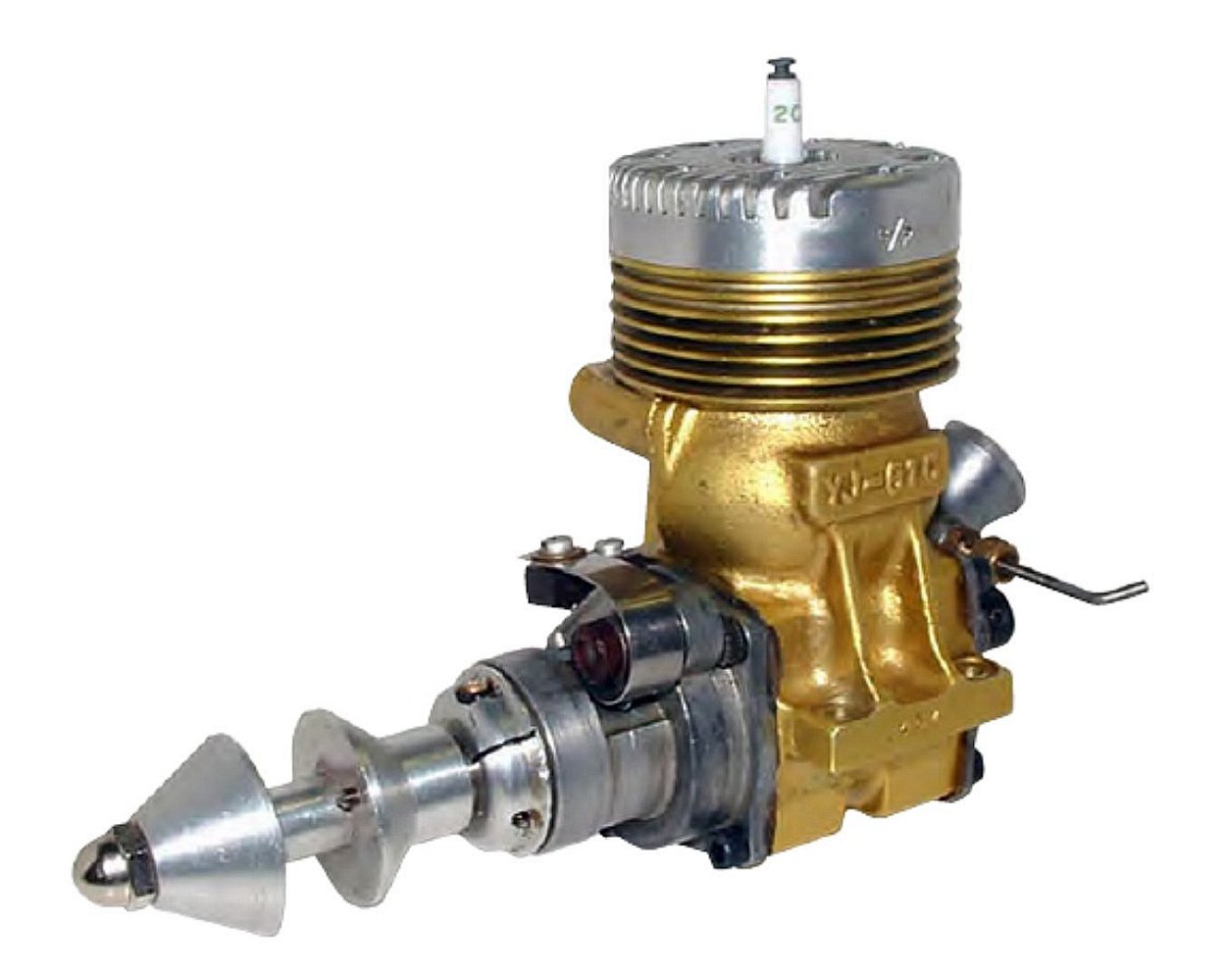 In 1994 Don acquired the residue of the Yellow Jacket racing engine project which had been initiated back in the late 1950’s by Bruce Underwood in response to a growing number of crankcase failures with the iconic Dooling 61. Don subsequently completed some 70 more examples of these famous engines, two of which are now in my possession along with a sizeable number of other superb products from Don's workshop.
In 1994 Don acquired the residue of the Yellow Jacket racing engine project which had been initiated back in the late 1950’s by Bruce Underwood in response to a growing number of crankcase failures with the iconic Dooling 61. Don subsequently completed some 70 more examples of these famous engines, two of which are now in my possession along with a sizeable number of other superb products from Don's workshop.  A case in point arose during December, when my good Aussie mate Maris Dislers returned his attention to the Mite .099 fixed-compression diesel from Brooklyn, New York. Maris was able to provide me with a completely revised text based upon his most recent testing efforts. As if that wasn’t enough, he also came up with a whole host of additional published sources of information on this very forward-looking little engine.
A case in point arose during December, when my good Aussie mate Maris Dislers returned his attention to the Mite .099 fixed-compression diesel from Brooklyn, New York. Maris was able to provide me with a completely revised text based upon his most recent testing efforts. As if that wasn’t enough, he also came up with a whole host of additional published sources of information on this very forward-looking little engine. 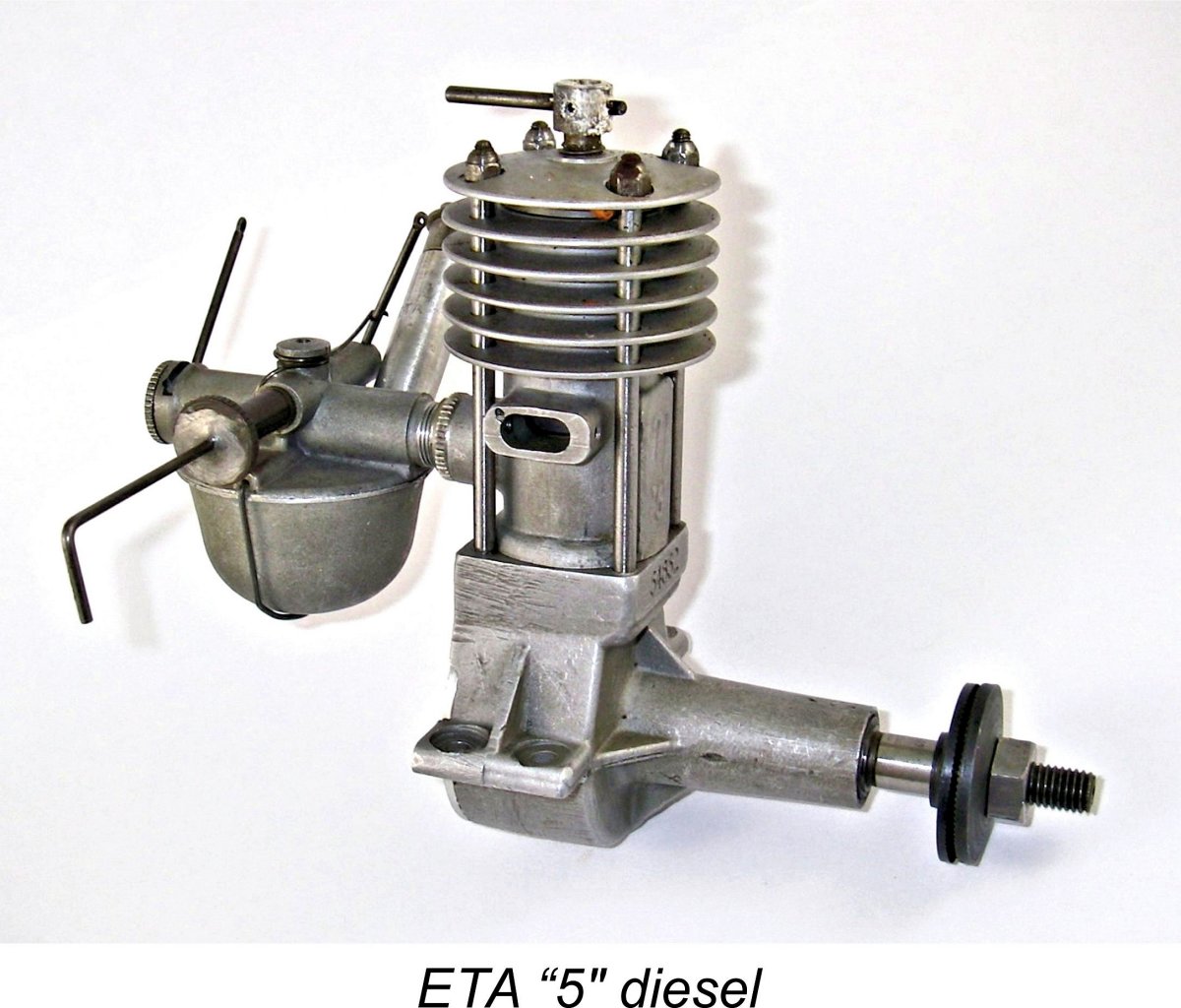 In the same vein, it was a great pleasure to hear from Lyndon Bedford, the son of ETA designer and manufacturer Ken Bedford. Lyndon was able to supply a few additional serial numbers for early ETA engines. Of perhaps the greatest significance, Lyndon was able to show that the company’s first model, the ETA “5” side-port diesel, actually appeared in late 1946, considerably earlier than had been supposed on the basis of the advertising trail, which didn’t begin until July 1947. The number 124614 on his unit confirms that it was the 14
In the same vein, it was a great pleasure to hear from Lyndon Bedford, the son of ETA designer and manufacturer Ken Bedford. Lyndon was able to supply a few additional serial numbers for early ETA engines. Of perhaps the greatest significance, Lyndon was able to show that the company’s first model, the ETA “5” side-port diesel, actually appeared in late 1946, considerably earlier than had been supposed on the basis of the advertising trail, which didn’t begin until July 1947. The number 124614 on his unit confirms that it was the 14

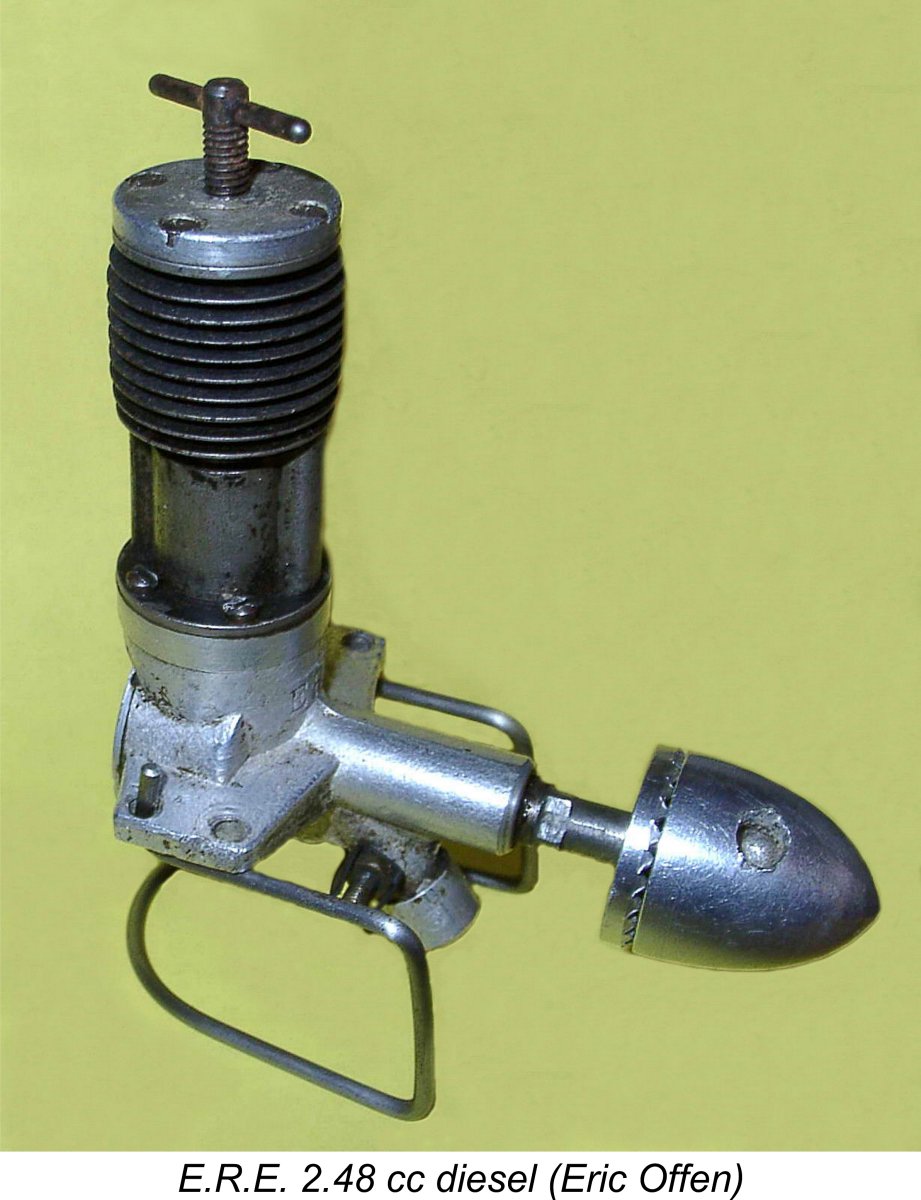
 The McCoy “9” broke a significant number of design barriers for Dick McCoy. It was his first-ever crankshaft front rotary valve (FRV) design, also being the smallest-ever commercial product from any designer to feature a ringed light alloy piston. It subsequently became McCoy’s first-ever model to feature a lapped piston following an early design change. It served as the prototype for a long line of McCoy FRV sports engines which represented a complete departure from the racing-type models previously associated with the McCoy name. Finally, along the way it became the subject of one of Dick McCoy’s rare errors of judgement. All of this elevates the humble McCoy “9“ to the status of a particularly rewarding model to study. I think that you’ll find yourself perhaps unexpectedly enjoying its story!
The McCoy “9” broke a significant number of design barriers for Dick McCoy. It was his first-ever crankshaft front rotary valve (FRV) design, also being the smallest-ever commercial product from any designer to feature a ringed light alloy piston. It subsequently became McCoy’s first-ever model to feature a lapped piston following an early design change. It served as the prototype for a long line of McCoy FRV sports engines which represented a complete departure from the racing-type models previously associated with the McCoy name. Finally, along the way it became the subject of one of Dick McCoy’s rare errors of judgement. All of this elevates the humble McCoy “9“ to the status of a particularly rewarding model to study. I think that you’ll find yourself perhaps unexpectedly enjoying its story! 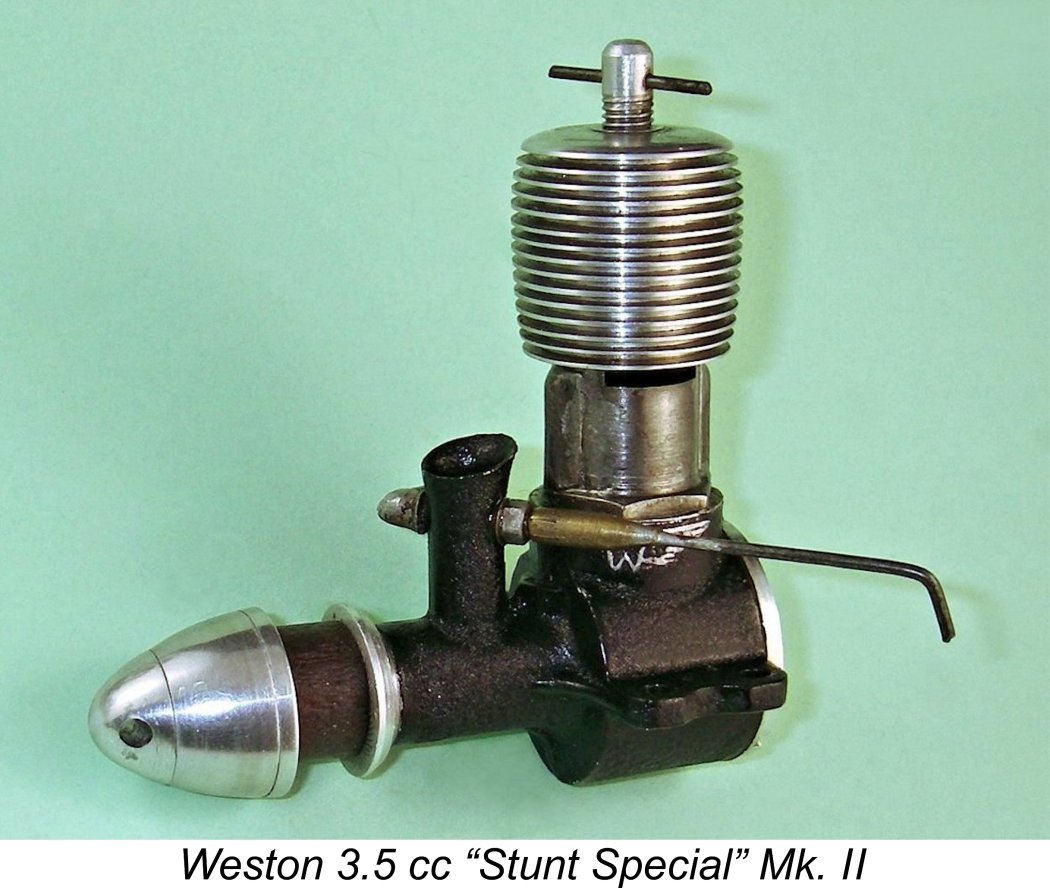 acquisition and test of a fine example of the very rare 3.5 cc Weston “Stunt Special” and have expressed a keen desire to seeing the results published sooner rather than later. I’m always keen to satisfy my friends’ wishes, so I’ve made a special effort to get the article ready for publication this month.
acquisition and test of a fine example of the very rare 3.5 cc Weston “Stunt Special” and have expressed a keen desire to seeing the results published sooner rather than later. I’m always keen to satisfy my friends’ wishes, so I’ve made a special effort to get the article ready for publication this month.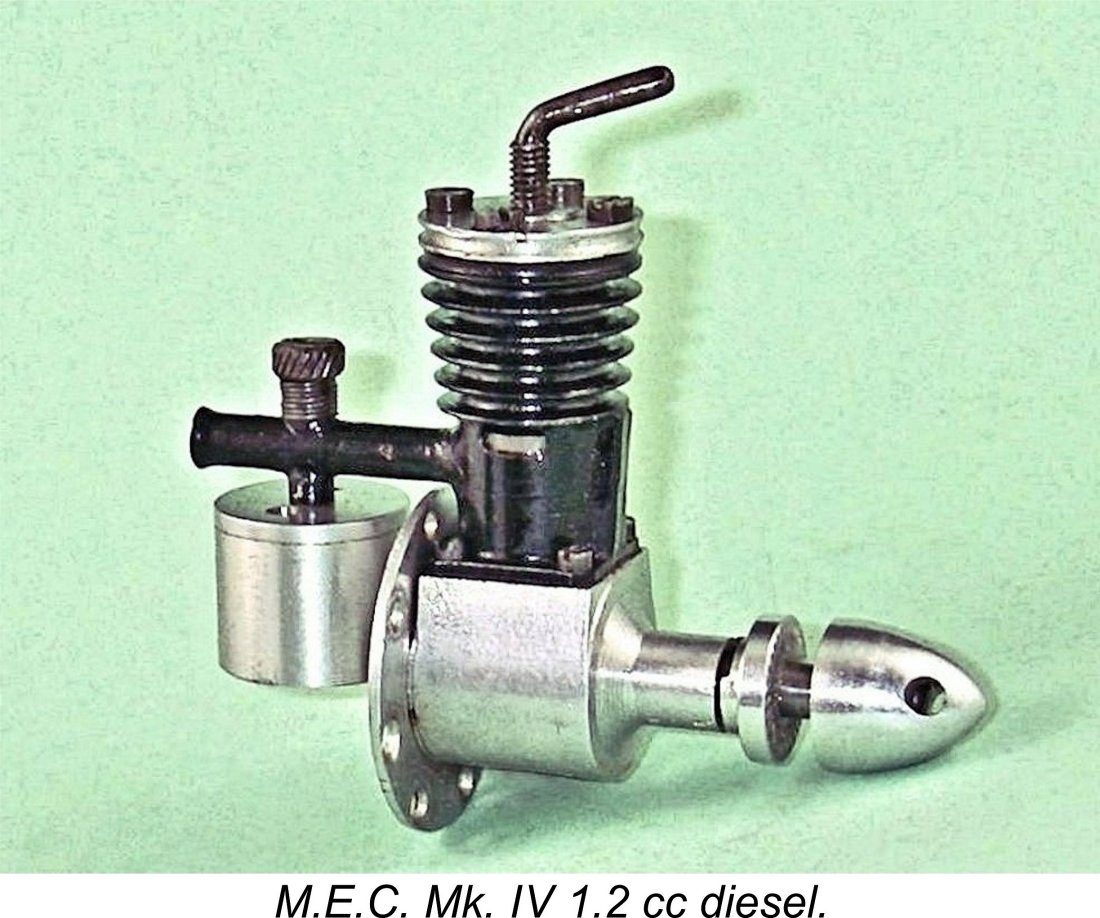 good to the engine's prospects since Sparey encountered a number of structural difficulties, all of which he reported. Only some 20 examples reportedly ended up being produced in total. My own testing has confirmed that the Weston "Stunt Special" was a far better engine than Sparey's report would indicate. I hope that my article will convince a few of you!
good to the engine's prospects since Sparey encountered a number of structural difficulties, all of which he reported. Only some 20 examples reportedly ended up being produced in total. My own testing has confirmed that the Weston "Stunt Special" was a far better engine than Sparey's report would indicate. I hope that my article will convince a few of you!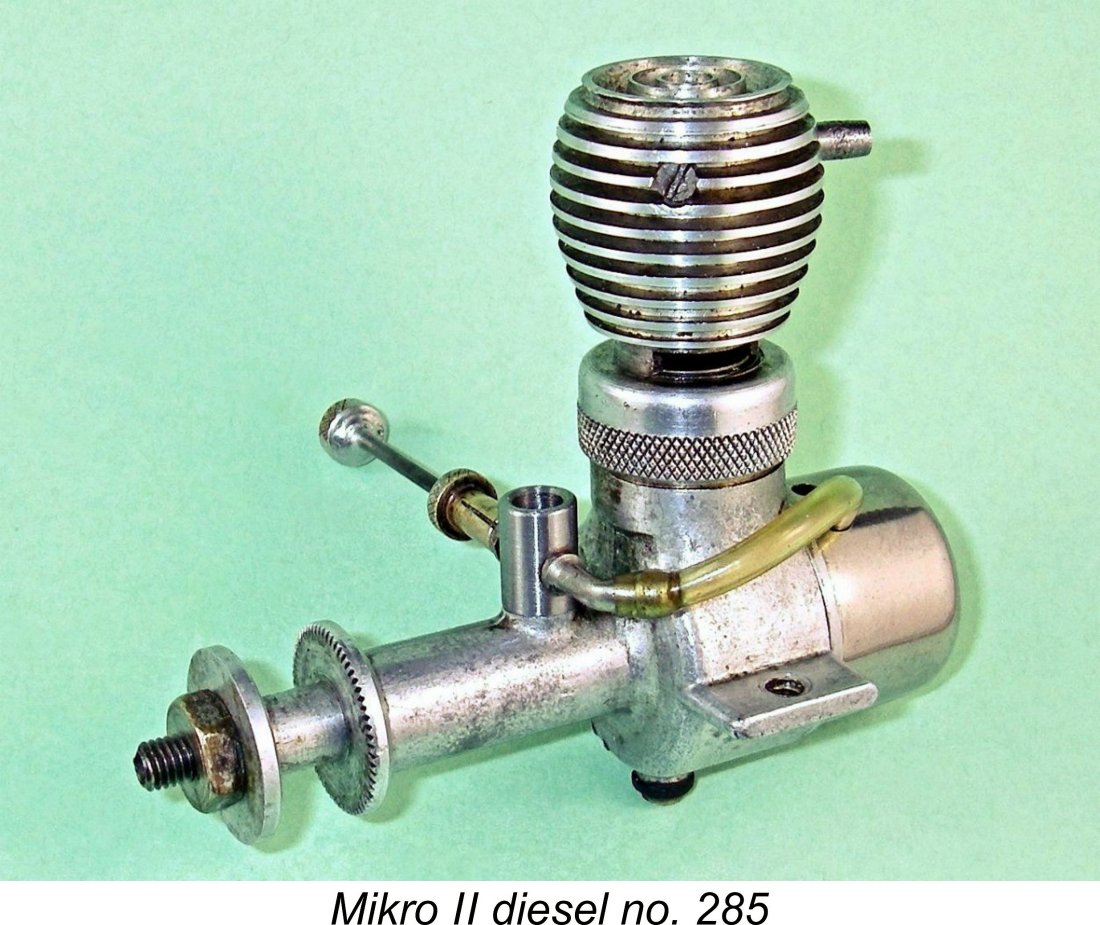 For next month, we’ll return to Scandinavia for the first time in a while to take a look at a fairly rare Danish engine, the 1948 Mikro II 2 cc diesel. This engine was mentioned in my earlier article on the
For next month, we’ll return to Scandinavia for the first time in a while to take a look at a fairly rare Danish engine, the 1948 Mikro II 2 cc diesel. This engine was mentioned in my earlier article on the 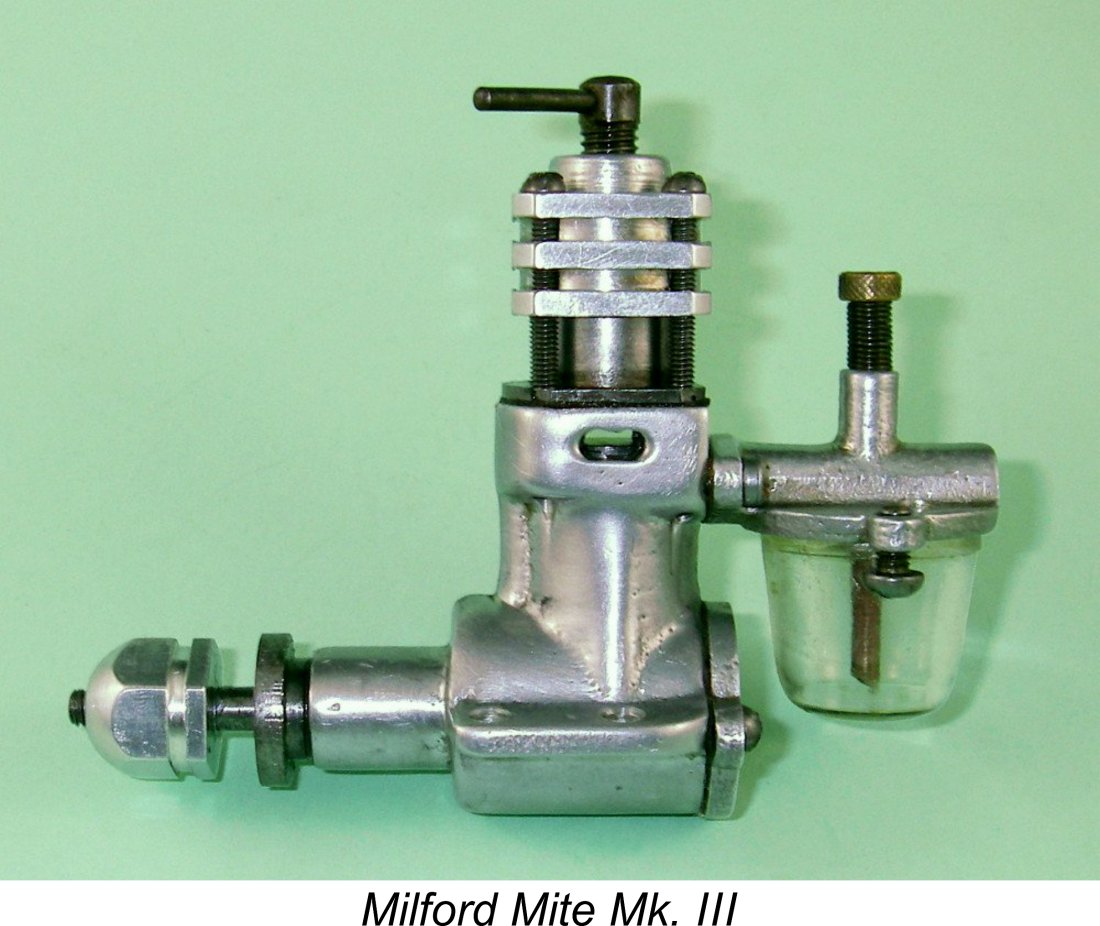 The MEN transfer article for the month will take the form of a re-mounting of my earlier article on the infamous 1.41 cc Milford Mite diesel from Harrow in England. I say “infamous” because this engine has consistently received a very bad press from earlier writers! It has even been described as “probably the worst diesel ever to appear in Britain”. Statements like that definitely invite testing, and I hope that you’ll enjoy reading about my efforts to do just that!
The MEN transfer article for the month will take the form of a re-mounting of my earlier article on the infamous 1.41 cc Milford Mite diesel from Harrow in England. I say “infamous” because this engine has consistently received a very bad press from earlier writers! It has even been described as “probably the worst diesel ever to appear in Britain”. Statements like that definitely invite testing, and I hope that you’ll enjoy reading about my efforts to do just that!